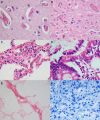Quantitative Assessment of Multiorgan Sequestration of Parasites in Fatal Pediatric Cerebral Malaria
- PMID: 25852120
- PMCID: PMC4577044
- DOI: 10.1093/infdis/jiv205
Quantitative Assessment of Multiorgan Sequestration of Parasites in Fatal Pediatric Cerebral Malaria
Abstract
Children in sub-Saharan Africa continue to acquire and die from cerebral malaria, despite efforts to control or eliminate the causative agent, Plasmodium falciparum. We present a quantitative histopathological assessment of the sequestration of parasitized erythrocytes in multiple organs obtained during a prospective series of 103 autopsies performed between 1996 and 2010 in Blantyre, Malawi, on pediatric patients who died from cerebral malaria and controls. After the brain, sequestration of parasites was most intense in the gastrointestinal tract, both in patients with cerebral malaria and those with parasitemia in other organs. Within cases of histologically defined cerebral malaria, which includes phenotypes termed "sequestration only" (CM1) and "sequestration with extravascular pathology" (CM2), CM1 was associated with large parasite numbers in the spleen and CM2 with intense parasite sequestration in the skin. A striking histological finding overall was the marked sequestration of parasitized erythrocytes across most organs in patients with fatal cerebral malaria, supporting the hypothesis that the disease is, in part, a result of a high level of total-body parasite sequestration.
Keywords: Africa; Malawi; autopsy; cerebral malaria; pathology; pediatrics.
© The Author 2015. Published by Oxford University Press on behalf of the Infectious Diseases Society of America. All rights reserved. For Permissions, please e-mail: journals.permissions@oup.com.
Figures

References
-
- WHO Global Malaria Program. World malaria report 2011. Geneva: World Health Organization, 2011.
-
- Taylor TE, Fu WJ, Carr RA, et al. Differentiating the pathologies of cerebral malaria by postmortem parasite counts. Nat Med 2004; 10:143–5. - PubMed
-
- Milner DA, Taylor TE. Continuing study of pediatric fatal malaria in Blantyre, Malawi. Int J Parasitol 2008; 38(supp 1):S22.
Publication types
MeSH terms
Grants and funding
LinkOut - more resources
Full Text Sources
Other Literature Sources

